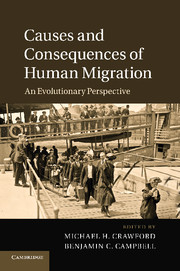Book contents
- Frontmatter
- Contents
- Contributors
- Preface
- 1 Perspectives on human migration: introduction
- Section 1 Theory
- Section 2 Geography and migration
- 8 Population structure and migration in Africa: correlations between archaeological, linguistic, and genetic data
- 9 Human migrations in North Africa
- 10 Identity, voice, community: new African immigrants to Kansas
- 11 The African colonial migration into Mexico: history and biological consequences
- 12 Demic expansion or cultural diffusion: migration and Basque origins
- 13 Consequences of migration among the Roma: immunoglobulin markers as a tool in investigating population relationships
- 14 Migration, assimilation, and admixture: genes of a Scot?
- 15 Mennonite migrations: genetic and demographic consequences
- 16 Human migratory history: through the looking-glass of genetic geography of Mycobacterium tuberculosis
- 17 Peopling the Tibetan plateau: migrants, genes, and genetic adaptations
- 18 Migration, globalization, instability, and Chinese in Peru
- 19 The great blue highway: human migration in the Pacific
- 20 Migration of pre-Hispanic and contemporary human Mexican populations
- 21 A review of the Tupi expansion in the Amazon
- 22 Molecular consequences of migration and urbanization in Peruvian Amazonia
- 23 Migration in Afro-Brazilian rural communities: crossing historical, demographic, and genetic data
- 24 Indentured migration, gene flow, and the formation of the Indo-Costa Rican population
- 25 Causes and consequences of migration to the Caribbean Islands and Central America: an evolutionary success story
- Section 3 Overview
- Index
- References
13 - Consequences of migration among the Roma: immunoglobulin markers as a tool in investigating population relationships
Published online by Cambridge University Press: 05 December 2012
- Frontmatter
- Contents
- Contributors
- Preface
- 1 Perspectives on human migration: introduction
- Section 1 Theory
- Section 2 Geography and migration
- 8 Population structure and migration in Africa: correlations between archaeological, linguistic, and genetic data
- 9 Human migrations in North Africa
- 10 Identity, voice, community: new African immigrants to Kansas
- 11 The African colonial migration into Mexico: history and biological consequences
- 12 Demic expansion or cultural diffusion: migration and Basque origins
- 13 Consequences of migration among the Roma: immunoglobulin markers as a tool in investigating population relationships
- 14 Migration, assimilation, and admixture: genes of a Scot?
- 15 Mennonite migrations: genetic and demographic consequences
- 16 Human migratory history: through the looking-glass of genetic geography of Mycobacterium tuberculosis
- 17 Peopling the Tibetan plateau: migrants, genes, and genetic adaptations
- 18 Migration, globalization, instability, and Chinese in Peru
- 19 The great blue highway: human migration in the Pacific
- 20 Migration of pre-Hispanic and contemporary human Mexican populations
- 21 A review of the Tupi expansion in the Amazon
- 22 Molecular consequences of migration and urbanization in Peruvian Amazonia
- 23 Migration in Afro-Brazilian rural communities: crossing historical, demographic, and genetic data
- 24 Indentured migration, gene flow, and the formation of the Indo-Costa Rican population
- 25 Causes and consequences of migration to the Caribbean Islands and Central America: an evolutionary success story
- Section 3 Overview
- Index
- References
Summary
Introduction
This volume is aimed at looking at the causes and consequences of human migration. Our chapter concentrates on the Roma of Europe. Although, as we will see, the causes of the migration of the Roma populations from their homeland in India is lost in time, there is a great deal of evidence of the consequences of their migration over time. Most studies of the Roma look at single systems. The following review includes linguistic and genetic data on the Roma. The genetic data are divided among single nucleotide polymorphism (SNP) disease markers, mitochondrial DNA (mtDNA) and non-recombinant Y-chromosome SNP (NRY SNP) markers, and autosomal STR data with a synthesis of the data on the immunoglobulin allotype ancestry informative SNP markers. Though some markers are less useful than others, the general genetic pattern traces the Roma to the northern India–Pakistan region.
The Roma (Gypsies) currently live in endogamous communities scattered throughout Europe and elsewhere, which have been described as a “conglomerate of genetically isolated found populations” (Kalaydjieva et al., 2001). According to the review by Kalaydjieva et al. (2001) the largest Roma populations live in Bulgaria, Hungary, Romania, Slovakia, and Spain, followed by significant populations in the Czech Republic, France, Germany, Greece, Italy, Macedonia, Montenegro, Russia. Serbia, and Turkey, with smaller populations in Albania, Austria, Belarus, the Benelux countries, Bosnia, Croatia, Poland, Portugal, Switzerland, Ukraine, and the United Kingdom, while the smallest groups live in the peripheral Baltic States, Denmark, Finland, and Sweden. The term “Gypsy” comes from the concept that the population originated in Egypt and often refers to highly mobile populations. The Roma or Rom consider the term derogatory and most of the European Roma populations are sedentary. External terms for the Roma usually considered derogatory include Gypsy, Gitane, Gitano, Ijito, Jifti, Cingene, Sigane, Zigeuner, Sigojner, Tattare, and Tatere, while internal terms include Rom, Sinti, Mafia, and Calo or Kaalo. They are also named based on where they live – Vlah (Romania), Serbica (Serbia), Rom-ungro (Hungary) – and occupational classes – Lovari (horse), Kalderash (kettle), or Kalayde (tin smith) (Bakker, 2007).
- Type
- Chapter
- Information
- Causes and Consequences of Human MigrationAn Evolutionary Perspective, pp. 250 - 268Publisher: Cambridge University PressPrint publication year: 2012



